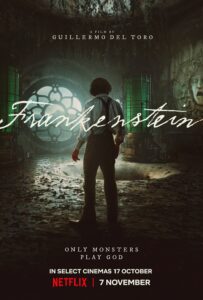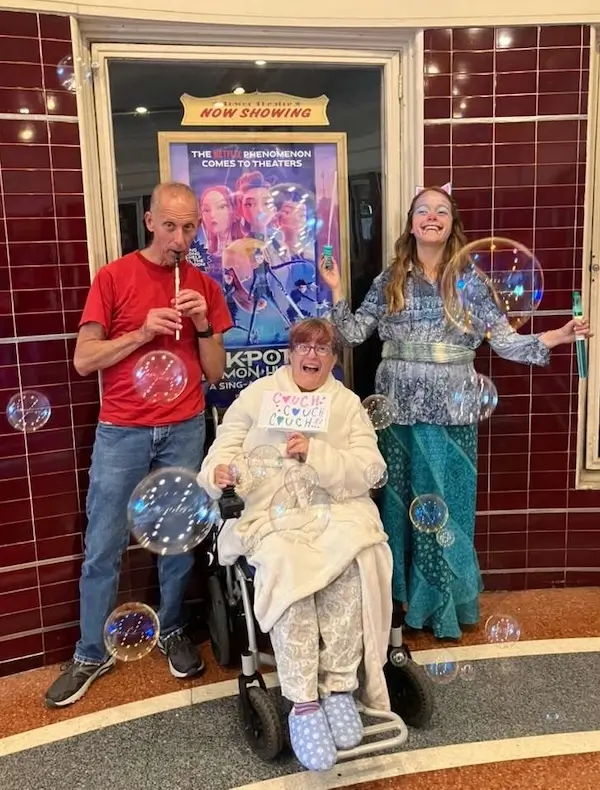* One of Carrie’s popular features in Smart Bitches After Dark are her movie reviews and recaps, which we’ve given the Very Original name, *After Dark at the Movies.
One of Carrie’s popular features in Smart Bitches After Dark are her movie reviews and recaps, which we’ve given the Very Original name, *After Dark at the Movies.
*Carrie is usually very excited to recap from her couch, but she was determined to see Guillermo del Toro’s Frankenstein and share it with the After Dark community. *
*Trying to figure out where to see it led to this post. *
…
 One of Carrie’s popular features in Smart Bitches After Dark are her movie reviews and recaps, which we’ve given the Very Original name, *After Dark at the Movies.
One of Carrie’s popular features in Smart Bitches After Dark are her movie reviews and recaps, which we’ve given the Very Original name, *After Dark at the Movies.
*Carrie is usually very excited to recap from her couch, but she was determined to see Guillermo del Toro’s Frankenstein and share it with the After Dark community. *
*Trying to figure out where to see it led to this post. *
…

I’ve been very, very excited about Guillermo del Toro’s film version of Frankenstein. It will be released on Netflix on November 7, 2025, and is being shown starting on October 17 in limited theatrical release. Honestly, I didn’t think it was likely to play in my town of Sacramento, but it turns out that it is playing in Sacramento, albeit not until the weekend of October 23rd. It’s even playing in a theater that I can visit – a big chain theater as opposed to the local arthouse.
Here’s why I can’t see it in the local arthouse.
Frankenstein is playing in, among other places, one of Sacramento’s oldest, most historic theaters. This location shows old movies as well as new, mostly independent movies. The theater is a local treasure. Because it’s an old building, I would not expect it to be fully accessible. I’m not an expert on the details of the Americans with Disabilities Act, but I assume that some allowances are made for historic buildings, and I understand why this might be the case. But my recent experience with this theater was stressful, embarrassing, and dangerous.
I’m sharing this not to wreak my vengeance upon the theater in question but rather because it is a perfect example of how a business can create “accessibility” on paper while remaining utterly inaccessible in practice. It’s also a good example of how we don’t notice barriers until we run smack into them ourselves. I haven’t gone to a movie theater in ages so it was a rude awakening when I tried to see KPOP Demon Hunters Sing-a Long as a wheelchair user – my first time at the movies as a wheelchair user.
We got our tickets and made our way into the theater viewing room. Inside, we found a wheelchair lift that was locked (you have to go up and down stairs to get to seats). My husband went to find an employee who had to find the key. The employee had to get a key from the manager. The employee, now armed with a key, activated the lift, and as soon as I rolled out, turned the lift off and began to leave with the key.
My husband and I pointed out that if she left with the lift locked, then if there was a fire or other emergency a non-ambulatory wheelchair user would be trapped.
Further, I was not only locked out of the lift, but I realized that the row it took me to was only a few rows back from the screen and that the seating was behind a short wall.
Both of these obstacles would make it difficult to see the movie.
Because I’m ambulatory and was accompanied by able-bodied people, I was able to leave my wheelchair in wheelchair seating and climb some steps to a better row. It was awkward, embarrassing, and painful.
But what makes me even more angry is that I had many different kinds of privilege that not all disabled people share. My experience was frustrating, but for others it would be actively dangerous.
It turns out that this is a problem in a lot of movie theaters. In fact, my local arthouse is ahead of the curve in that it does not force wheelchair users to limit themselves to the very front row. AMC, Cinemark, and Regal have both faced multiple lawsuits involving wheelchair access, including legal challenges that state that wheelchair users should have equal quality sightlines as ambulatory viewers.
A brilliant tumblr post by @urbancripple brilliantly states, “If You’re Gonna Make Something Accessible, Don’t Make It a Thing.” This post gives examples of situations in which something is accessible but awkward and situations when accessibility is not awkward:
The buses are wheelchair accessible but the driver has to stop the bus, take 30 seconds to lower the goddamn ramp, move passengers out of their seats, hook up the straps and then secure you in the bus. Sure, they’ve made the buses accessible but now it’s a thing.
And it gives examples of when accessibility is not a thing:
The train to the airport pulls up flush with the platform. I board with everyone else and sit wherever the fuck I want. Riding the train is accessible and not a thing.
I highly recommend the post for anyone interested in the complex world of accessibility.
What I experienced at the movie theater was A Thing.
It involved an employee, a manager, the search for a key, and, when that proved inadequate, my friends basically hauling me up some stairs so that I could actually see the movie I had paid for. On top of that, it was dangerous. And after all that drama, if I had stayed in the “wheelchair” seating, my view would have been obstructed by this weird-ass wall and by being so close to the screen.
I learned a lot from this experience. One thing I learned is how very difficult it is to see beyond your own level of privilege – a lesson I learn time and again. In the case of wheelchair access, before I used a wheelchair, I thought in terms of the most obvious accommodations, like ramps and elevators. I had no idea that not all ramps, or elevators, are created equal. I had no clue about the many odd frustrations that one encounters as a wheelchair user. Since I’m an ambulatory user, I probably miss a thousand other frustrations that I’d encounter as a non-ambulatory user. No matter how much you watch or read or think about, the only way to know what using a wheelchair is like is to sit in one – and even then every experience is different because every user is different.
I also got to see what allyship looks like in action. I’d love to tell you that, when this whole wheelchair lift drama was unfolding, I fiercely advocated for myself and fellow wheelchair users, but this was not the case. I did not feel fierce. I felt embarrassed. I wanted to hide. I wanted to go home. I do not like fusses being made over me. I don’t like putting people out.
Were I speaking to a friend in a similar situation, I would of course say, “You have no reason to be embarrassed. The theater created this issue and now they have to solve it. And your friends want to see the movie in your company, so unless they want to sit with you three rows or so from the screen, they are going to help you. Also, this situation is totally fucked and that’s not on you.”
But I’m sure I’m not the only person who talks one way to others and another way to the inside of my own head.
In the moment, it was my able-bodied family who came to my defense as allies – hunting down someone who could operate the lift, helping me on the stairs, and getting the lift unlocked again, not to mention expressing their displeasure to the manager and filing a complaint with their parent company and on ADA.gov (we have not received a response from either the theater’s parent company or the ADA to date). They really modeled for me what allyship looks like, and helped me get more confidence about advocating for myself.
It’s ironic that the movie I was trying to see was KPop Demon Hunters Sing-a-Long, a movie which discusses living as our full and total selves. It’s also ironic that the movie I won’t be seeing there is Frankenstein, given del Toro’s deep love for people and beings who are different, who in some way feel they are not fully accepted by society.
Accessibility can be difficult because no two people are the same, and because older buildings have great historic value but were simply not built with handicapped accessibility in mind.
Still, even given outmoded infra-structure, the theater staff could have handled this better.
They could have been polite (the manager with the key neither spoke to me nor looked me in the face).
They could have told me what future changes, if any, they had in mind.
They could have tried out the seating for themselves when they first installed the lift, and seen how poor the visibility was and either adjusted accordingly or, if it was simply impossible to work out something better given the age of the building, they could have offered a discount and an apology.
They could have treated me like a valued customer and not an incredibly irritating inconvenience.
So, friends, that’s why I won’t be seeing Frankenstein in the arthouse theater, unless of course it happens to open up in other local venues (fingers crossed!). I’m pretty sad, too, because that theater shows a lot of movies I’d enjoy seeing on the big screen.
However, I learned a lot about myself and my family and friends, I learned how to handle similar situations, and I learned that you can file a complaint with the ADA about disability accommodations at https://www.ada.gov/file-a-complaint/.
If not for the work of many disabled activists, I wouldn’t be going to any theater at all, but it seems likely that the megaplex will work out as a solution to my Frankenstein quest – I’ll report back!
 Greetings from the KPOP Sing Along!
Greetings from the KPOP Sing Along!
Stay tuned, After Dark folks – Carrie’s review of Frankenstein will be up shortly! And if you’d like tojoin After Dark to help keep the site open for everyone, you can do that here!